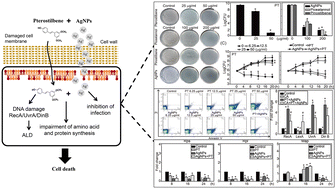Novel antibacterial activity of silver nanoparticles combined with pterostilbene against Staphylococcus aureus via induction of apoptosis-like cell death and downregulation of ribosomal gene expression†
Abstract
Silver nanoparticles (AgNPs) have been used as antimicrobial agents; however, the potential toxicity of AgNPs limits its application. Pterostilbene (PT) is a stilbene compound known for many functions, including its antibacterial and anti-inflammation properties. At present, there is a growing interest in the combination of nanoparticles with other antibacterial agents, considering that this approach may promote more effective antibacterial activity against pathogens and minimize the side effects. Therefore, the purpose of this study was to elucidate the antibacterial activity of AgNPs combined with PT against Staphylococcus aureus (S. aureus), and deeper antibacterial mechanisms were studied. The results indicated that AgNPs combined with PT showed excellent antibacterial effects against S. aureus, as evidenced by the inhibition zone experiment, minimum inhibitory concentration (MIC), minimum bactericidal concentration (MBC), fractional inhibitory concentration (FIC) index, time-kill curve test, and viability assay. After combined treatment, the ROS production and apoptosis-like cell death (ALD) were increased. The next-generation sequencing study confirmed the genetic changes related to ALD, including the upregulation of RecA, UvrA and the downregulation of LexA. More importantly, the ribosome-relevant genes RpsT and RplE were downregulated, and the S. aureus infection gene Map was also downregulated after treatment. In summary, the study reveals that AgNPs combined with PT have better antibacterial activity against S. aureus. It further demonstrates a novel antibacterial mechanism through induction of ALD and downregulation of ribosomal gene expression for the first time that could be an interesting prospect for the future development of nanoparticles against other pathogens.



 Please wait while we load your content...
Please wait while we load your content...